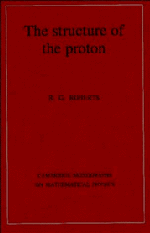Book contents
- Frontmatter
- Contents
- Preface
- 1 Introduction
- 2 Structure functions
- 3 Quark parton model
- 4 Perturbative QCD
- 5 Applying QCD to deep inelastic scattering
- 6 Large and small x
- 7 The parton distributions
- 8 Quarks and gluons in nuclei – structure of the bound nucleon
- Appendix: Radiative corrections
- References
- Index
- Frontmatter
- Contents
- Preface
- 1 Introduction
- 2 Structure functions
- 3 Quark parton model
- 4 Perturbative QCD
- 5 Applying QCD to deep inelastic scattering
- 6 Large and small x
- 7 The parton distributions
- 8 Quarks and gluons in nuclei – structure of the bound nucleon
- Appendix: Radiative corrections
- References
- Index
Summary
The description of interactions of particles in terms of the standard model is proving remarkably robust. In this scheme, the electroweak interactions between the leptons and quarks are described by the gauge field theory with broken SU(2) × U(1) symmetry with the associated gauge bosons of the photon, W and Z, while the strong interactions of quarks are governed by quantum chromodynamics (QCD) with SU(3) symmetry where the gauge boson is the gluon. QCD provides a theoretical framework for formulating the structure of hadrons, in particular that of the proton, in terms of quarks and gluons. This structure is revealed when the proton is probed by a virtual photon or weak current at high energy. This is known as deep inelastic scattering by leptons off a nucleon target and is the subject of this book.
I am indebted to many people for educating me in the subtleties of theory and experiment. Especially I thank Graham Ross, Frank Close, Alan Martin, James Stirling and Roger Phillips on the theoretical and phenomenological front. I have benefitted from discussions with Erwin Gabathuler, Peter Norton and Terry Sloan who with their colleagues provided much of recent excitement on the experimental front. Correspondence with Jan Kwiecinski and Louis Miramontes was a great help. I am grateful to Greg Moley for preparing the text in TEX. Finally I thank Peter Landshoff for continual encouragement.
- Type
- Chapter
- Information
- The Structure of the ProtonDeep Inelastic Scattering, pp. ix - xPublisher: Cambridge University PressPrint publication year: 1990



